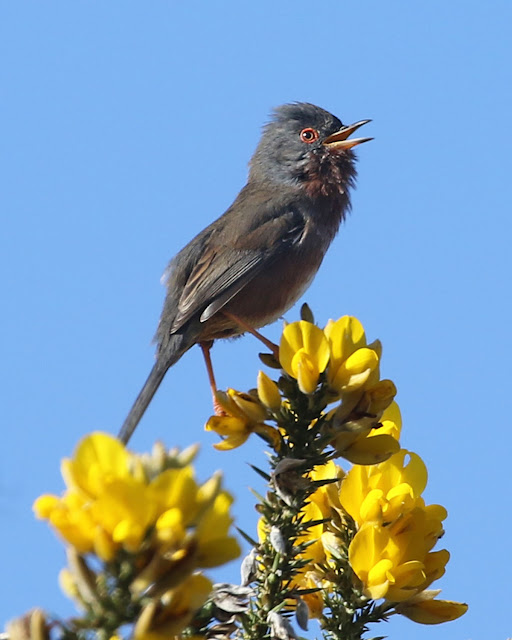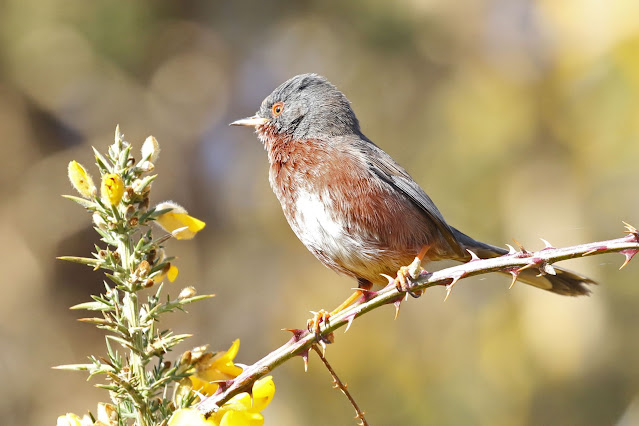A mixed forecast today but as I arrived in the car park at Bridge Street in Titchfield it was raining. This though did not appear to stop the local resident birds from singing, stepping out of the car I could hear, Song Thrush, Blackbird, Great Tit and Robin, with bursts of song from a nearby Wren.
Once Ian arrived we crossed the road to see if we could find the Glossy Ibis, but they were no where to be seen. We then set off along the canal path, stopping as always to check the resident Barn Owl in the usual tree.
The rain was becoming more persistent and despite the fact sun rise was early it was very gloomy. Out hope was that the drizzle would bring in some early migrants, both Sand martin and Little Ringed Plover had been seen in the week, but this morning there was no sign of anything. The only indication that spring had started was the brief trickle of song from the Chiffchaffs.
Stock Dove could be heard calling from the trees along side the path and this pair were surprising content to allow us to get close.
A little further along the drizzle did not appear to deter this Song Thrush from singing, again allowing us to get quite close.
There was no sign of any hirundines over Posbrook Floods but still good numbers of duck with Wigeon, Pintail, Teal and Gadwall all present. We walked as far as the the thatched cottage with very little of interest on the way. Walking back I slipped in the mud and fell which was a wake up call for me.
The willow trees along side the canal were covered in buds and in places the buds were flowering, also known as Pussy willow they looked lovely against a dark background.
Posbrook Floods was now covered with gulls, mostly Black-headed but there were a few Mediterranean Gulls and you could hear their calls as they flew over.
We had been hearing a Great Spotted Woodpecker both drumming and calling. Eventually we were able to locate at the top of one of the oak trees.
Back at the car park we crossed to check the horse paddocks once more, but with no sign once again of the Ibis.
From Bridge Street we headed off to Hill Head, the skies were clearing but away to the north there was still a block of dark grey clouds, the sunshine emphasising them against the golden colour of the Titchfield reed beds.
Out over the Solent the sun was managing to break through the clouds.
The tide was high and there was a Great Crested Grebe close to the sea wall.
A scan of the Solent found a smart summer plumaged Sandwich Tern on one of the yellow buoy, too far away for the camera though, a first for the year.
We decided to check the high tide roost but were distracted by a very smart male Pied Wagtail on the fence of the sailing club.
There was about sixty Sanderling in the high tide roost, huddled together but with one eye always alert to any possible danger
It has been a while since I have photographed the Sanderling, but today with the sunshine and the breaking surf behind them, there silvery grey winter plumage stood out. I was particularly taken by one bird that was out on its own. These are all the same bird, but with changing backgrounds.
Almost as effective in black and white.
The water level was high at the harbour bridge and a group of five male Mallard were attacking a female. The pair managed to get away and almost immediately the female attacked one of the males and the five beat a hasty retreat.
A Black Headed Gull had commandeered one of the kingfisher posts and would defend it from other gulls if they came close by screaming at them and pointing an open red bill and mouth.
I am sure any American birder would consider this to be a spectacular looking gull should it turn up on the east coast, but for us it is just a noisy Black-headed Gull, but there is beauty there.
On the other side of the road the Turnstones were occupying the breakwaters.
After checking in at the Visitor Centre i headed for the Meon Shore Hide to be greeted by the constant calling of pre breeding Black-headed Gulls, they were everywhere. It was though an opportunity to use the water reflections and the changing weather conditions to compose some more different shots.
It is most definitely not a 'seagull' and is found commonly
almost anywhere inland. Black-headed Gulls are sociable, quarrelsome, noisy
birds, usually seen in small groups or flocks, often gathering into larger
parties where there is plenty of food, or when they are roosting.
The Black-headed
Gull is one of the few hooded gulls that does not actually have a black head
during breeding. Its hood is dark chocolate brown.
Some Black-headed Gulls take on a rosy flush on the breast in their breeding plumage. This individual stood out amongst the other with a bright pink flush.
It is a case of waiting and eventually something else will come close to the hide as was the case with a pair of Shoveler, the female first.
Then the male.
Who decided it was time for a wash and brush up.
Three Greylag geese flew straight at the hide.
And from the right hand side a drake Gadwall appeared, an over looked duck with its own special beauty.
The blue sky was reflecting on the waters of the scrape and made for an interesting background for this Redshank.
I left the reserve and made my way back to the car for lunch, the Solent was looking wonderful and the tide was still quite high. Distantly there was a group of four Eider, two males and two females.
With the sunshine we decided to travel the short distance to Browndown South. We make the trip at the same time every year, but one day stands out in my memory the last Saturday out before we all were shutdown, I hope we never have to endure something like that again.
Walking around the gorse in the warm sunshine we quickly came across one of the site's specialties, the Dartford Warbler, this male singing from the gorse.
We managed to get closer.
And finally it came out of the gorse and showed very well.
The area is also very blessed with Greenfinch, their nasal calls and display flights very much a feature of the gorse.
We were here though to try and find Adders, Ian had found several over the last few days, so we headed to the spots where he had seen them. However as we arrived it started to rain, at time it was rain and sunshine, but it wasn't very conducive to Adders. The spots we knew of drew a blank, but as the rain stopped and sunshine returned we decided to walk around again. The return of the sun also brought out my first butterfly of the year a beautiful male Brimstone. The sun had also brought the Adder out, this male sitting just under the gorse amongst the old bracken and bramble.
This is the best time of the year to see Adders as they emerge from their winter hibernation, this one is a male, they usually emerge first and then later towards the end of March and into April, if you are lucky you can see the males "dancing" to win the right to mate with the larger female Adders.
This Adder was aware of me and followed me as I slowly tried to find an angle where the head was not obscured by the bits of bracken and bramble.
The phone in my pocket then vibrated and it was as if the Adder was aware of it and it started to edge away.
As it left it was flicking out it tongue.
The adder is the UK's only venomous snake, but its poison is
generally of little danger to humans: an adder bite can be painful and cause a
inflammation, but is really only dangerous to the very young, ill or old. If
bitten, medical attention should be sought immediately, however. Adders are
secretive animals and prefer to slither off into the undergrowth rather than
confront and bite humans and domestic animals; most attacks happen when they
are trodden on or picked up. Instead, they use their venom to immobilise and
kill their prey of small mammals, nestlings and lizards.
We left the search for Adders and set off to see if we could find something else. Walking down the slope the view across the gorse, out to the beach and the sea beyond it looked very Caribbean.
Another Brimstone appeared and this time was good to provide the first butterfly photograph of the year.
We could still hear singing Dartford Warblers and this individual showed very well after, at first, appearing with the sunshine behind it.
The Dartford warbler is a small, dark brown bird, with a
long tail, a distinctive red eye-ring and a cherry-red breast. It is most often
spotted warbling its rattly and scratchy song from the top of a gorse stem. At
other times, its muted tones allows it to blend in with the woody heather and
gorse.
It is dependent on mature, dry heath habitats in the
UK, and particularly on gorse that is in good condition for surviving cold,
harsh winters. It only eats insects and does not migrate for the winter, which
means it is vulnerable to cold weather and prolonged snow cover.
It is a ground-nesting bird, preferring to breed under the
protective cover of dense heather or compact gorse. It makes a grassy,
cup-shaped nest, in which it lays three to five eggs. It can have up to three
broods from April to July.
Leaving the Dartford Warbler we started to search the beach for possible Wheatear without any luck. It had been a beautiful afternoon once the shower had passed, warm as well in sheltered spots and that brought out the butterflies.
On the way home it was difficult not to remember a similar day and experiences three years ago, then we didn't know what was coming and as I said earlier I would not want to have to go through that once again.


















































































No comments:
Post a Comment